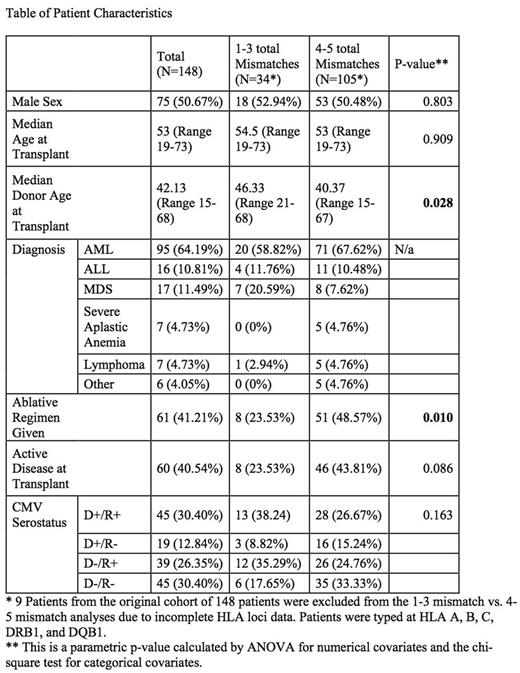Abstract
Introduction: For patients undergoing mismatched unrelated donor hematopoietic cell transplant (HCT), increased HLA mismatch has been associated with inferior survival.Whilehaploidentical HCT (haplo-HCT) with high dose post-transplantation cyclophosphamide (PTCy) offers a viable alternative for patients who do not have a matched sibling donor or matched unrelated donor, limited data are available regarding the impact of HLA disparity on outcomes. Specifically, no analysis to date has examined the role of mismatch degree in the graft-versus-host (GvH) and host-versus-graft (HvG) directions in a large, heterogenous cohort of patients undergoing peripheral blood T cell replete haplo-HCT. Thus, the purpose of our study was to examine the relationship between HLA disparity and clinical outcomes in patients receiving a peripheral blood T cell replete haplo-HCT.
Methods: We performed a single center retrospective study on 148 patients receiving PTCy-based peripheral blood T cell replete haplo-HCT from January 2010 to September 2016 (see table of patient characteristics). All patients age ≥ 18 were included regardless of diagnosis. Data on the match status at the following HLA loci were collected: A, B, C, DRB1, and DQB1. Patients were excluded from analyses for incomplete HLA loci data. Total mismatches (MM), class I, and class II mismatches were studied individually and mismatches were further classified as bidirectional, host-versus-graft (HvG), or graft-versus-host (GvH). The primary outcome was overall survival, and secondary outcomes included relapse-free survival, relapse, treatment-related mortality, acute graft-versus-host disease (GVHD), chronic GVHD, neutrophil engraftment, and platelet engraftment.
Results: HLA disparity was not associated with overall survival, relapse-free survival, relapse, treatment-related mortality, acute GVHD, or chronic GVHD. Greater HvG MM was associated with slower platelet and neutrophil engraftment. Specifically, patients with2 class II HvG MM's had significantly longer platelet engraftment time (median 35 vs. 28 days, p=0.025) when compared with 0-1 mismatches. Similarly, 4-5 total HvG MM had a trend towards longer platelet engraftment (median 35 vs. 31 days, p=0.056) when compared with 1-3 total HvG MM. 3 Class I HvG MM had a trend towards longer neutrophil engraftment (median 20 vs. 17 days, p=0.083) when compared with 0-2 class I HvG MM. Additionally, 2 class II HvG MM had a trend towards longer neutrophil engraftment (median 19 vs. 17 days, p=0.062) when compared with 0-1 class II HvG MM.
Conclusions: A higher number of class II HvG mismatches was associated with longer platelet engraftment but a greater level of HLA disparity was not associated with other clinical outcomes. Consequently, our data does not support selecting haploidentical donors based on HLA mismatch. Limitations of this study include its small sample size, treatment at a single center, and retrospective nature. Future prospective studies are needed to validate these findings.
No relevant conflicts of interest to declare.
Author notes
Asterisk with author names denotes non-ASH members.


This feature is available to Subscribers Only
Sign In or Create an Account Close Modal